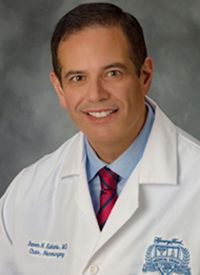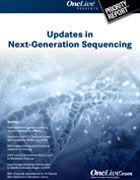NGS Enables Individualized Treatment Approach in Oncology
Steven N. Kalkanis, MD, explains how next-generation sequencing testing fits into cancer treatment today and efforts that need to be made to enable its widespread use in the future.
Steven N. Kalkanis, MD

Steven N. Kalkanis, MD
Next-generation sequencing (NGS) is the future of oncology, said Steven N. Kalkanis, MD, but its widespread use is dependent on researchers translating the data into improved patient outcomes.
“As a society and healthcare industry, we need to invest heavily in NGS because we have tools linking a patient's own genetic code with the genetics of what is driving their disease,” said Kalkanis, professor and chairman of the Department of Neurosurgery and medical director of the Henry Ford Cancer Institute. “We can design a treatment that is specific to them.”
The field has come a long way in terms of identifying actionable biomarkers across tumor types. These molecular markers, detected through NGS, can then be paired with FDA-approved therapies, allowing for more personalized treatment. This testing can also provide insight into why patients develop resistance to standard treatments.
In an interview with OncLive®, Kalkanis, who is also the Mark L. Rosenblum Endowed Chair in Neurosurgery and co-director of the Henry Ford Neuroscience Institute, explained how NGS testing fits into cancer treatment today and efforts that need to be made to enable its widespread use in the future.
OncLive: What is the current utility of NGS?
Kalkanis: Overall, we are living through an inflection point in medicine. Everything nowadays is viewed through a personalized targeted approach; NGS is what makes that possible. We are seeing its use in oncology, where it has had the biggest impact. One of the more exciting things is also happening in diabetes, heart disease, and a whole host of other diseases. We are now learning that some of these biomarkers and genetic aberrations can give physicians important clues as to how to tailor treatment specifically to a patient. It used to be treatment based just on the disease, but now it's based on the disease and the individual patient's genetics. This has created a cascading series of events that allow for NGS to happen.
We all need to ramp up in terms of our ability to do the testing and to do it in a cost-efficient way. We should be doing it in a high-yield setting where we know it's going to potentially change treatment. For instance, in oncology there are several different chemotherapies and radiation therapies that may work better, or not, based on someone's NGS profile.
How widespread is the use of NGS in oncology, and what can be done to make this more universally utilized?
Anyone can do the testing, but it is a complex algorithm to understand how one patient's hit on a particular biomarker impacts their treatment. Is it enough to put them on a certain therapy or clinical trial? That is the bottleneck for making NGS widely accessible. The expense and the intellectual capital needed to interpret the data are what’s impacting the use of NGS right now. However, we're now seeing that most academic centers around the country are investing in this [testing] as a path forward for the future. If you look across the country, there are probably 50 to 60 notable sites that have stepped forward and said they are going to make NGS the cornerstone of treatment.
Some of the things we are doing at Henry Ford Health System through telemedicine is attempting to link our experience here with community hospitals that may not have this capability. We're reaching out to a network of community physicians in smaller hospitals to say, “If you have a patient with this particular type of cancer, and you've done testing, let's talk about ways in which we can collaborate in clinical trials.” Oftentimes, that creates a win-win situation.
Our overall goal is to keep patients close to home but also to have the benefit of advanced testing, where appropriate. NGS is not something that can be recapitulated in every clinic across the country, again, because of the expense and the experience it takes to interpret the data.
What are some of the actionable biomarkers that can be detected by NGS?
There are so many; that's the exciting time we live in. Five years ago, there may have been 2 or 3, while today, there are numerous, depending on which disease you're talking about. Everyone knows about BRCA testing in breast cancer; there's EGFR, there are biomarkers that predict benefit from immunotherapy, and in brain cancer, there's IDH1. The IDH1 story is really compelling because now we can stratify the patients who are long-term survivors in the dreaded disease of glioblastoma.
The exciting thing is that now research is focused on changing a patient's genetic profile to a more favorable one if we know from the outset what their genetics are. Depending on which disease type you choose, there are several biomarkers that are coming to the forefront. There are probably too many to mention here.
What about prognostic indicators and identifying mechanisms of resistance?
There are several interesting stories that have come out in terms of resistance because now, with NGS and precision medicine, we can tell what else what might be going on that makes a patient resistant to a medication versus someone who responds. For example, a certain type of ovarian cancer in some patients led to a remission with a therapy, while in some patients it did not. With NGS testing, we were able to figure out that part of this tumor encoded something that acted almost like a viral vector or infection. It wasn't actually an infection; it was part of a virus that was causing a repeat in the genetic code that kept causing the cancer to repeat itself despite treatment. As soon as that viral particle was discovered, we developed a target that blocked that repeat of the virus. Suddenly, the therapy started working more effectively.
Other exciting opportunities may lie in drugs [that are already] inside medicine cabinets across the United States for other [indications]. These might be effective in oncology based on new prognostic indicators. [For example], there have been stories coming out about how diabetes medications block the cell division process in some cancer types, leading to remission. It's not designing a new drug, it's taking a drug meant for another purpose and giving it in the right settings to patients with cancer who have this biomarker [detected via] NGS testing. You're going to see a whole area of advancement in real-time.
You mentioned cost is a challenge, but is there potential for NGS to ultimately be cost-effective?
That's 100% the case, and that's the exact argument we've been giving to insurance carriers and those who are trying to design the payer system in this country. When you think about it, without NGS testing, you would put every patient through the standard of care. Some patients will do well on the standard approach, but a large number of patients will not.
Therefore, in those patients, you are paying for standard of care and then you are paying for second- and third-generation testing almost by trial and error. With NGS, if you know ahead of time that the standard of care is not going to work, going directly to a targeted treatment may, in fact, be more expensive. Looking at the whole episode of therapy, you are cutting out the cost of going into standard-of-care testing. You also won't waste precious time.
At the end of the day, you are spending less and getting a better outcome. We are trying to package this in a more holistic way in terms of how the patient does overall in the lifespan of what we will throw at them to treat their disease. We are seeing cost savings from that perspective. However, that's the daily struggle we face with insurers who are looking at cost per unit.
What is your experience dealing with local and regional payers with regard to NGS?
Their perspective is that this all falls under the domain of research, and as soon as you have a tried and true thing, they are willing to consider it. The problem is that all of this is playing out in real-time all over the world. These are new treatments coming forward, and these patients don't have time to wait 5 or 10 years for all of these studies to be fulfilled. If this was your wife, mother, or daughter, and you had evidence to show an approach works, what is enough to cause it to be paid as opposed to being left in a research bucket and not reimbursed?
What we've done—and this is a daily pushback that we get—is we constantly meet with payers and tell them we have a process here through our 15 disease-specific tumor boards where we vet every one of these NGS tests. If we can show by consensus that this testing will absolutely change the treatment and offer a targeted therapy for a given patient, then the insurance company will say, "If it's gone through these checks and balances, we will pay for it." That's a big win for us, because it's allowed for a fast tracking of getting patients the treatment they need.
It's hand-to-hand combat on a daily basis when it comes to showing the value of NGS. I can see it from their perspective because they don't want every physician who potentially can order a test to just click a box and say, "Let's do this." It does need to be rooted in some evidence that it can improve outcomes.
What is your take-home message about the future role NGS testing will have in oncology?
There's no question we are living the future. NGS testing is the future of getting a better outcome for the most devastating types of cancer. It is also applicable in diseases beyond cancer. Again, it's not just dollars, it's also the expertise as to how NGS should be used. It's also going to take cooperation between healthcare systems that may be competitors on some level. With the sharing of data, you get better outcomes.




